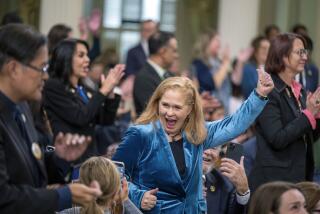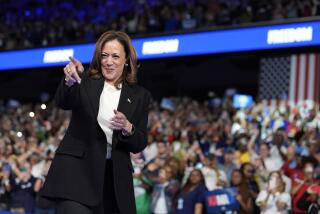California’s independent streak
CALIFORNIA VOTERS are shedding their identification with the two major political parties so rapidly that if current trends continue, independent voters could outnumber Democrats and Republicans in the Golden State by 2025.
These new independents, who eschew ideological loyalty and rigid partisan labels, represent a significant challenge to the mainstream parties. Already, California’s last few governors have needed to court independent voters to get elected, and in doing so, they fostered ideological tension within their parties; in the future, this struggle maybe become far more acute.
In the highly partisan Legislature, the influence of independents has until now been limited by a redistricting map that protects incumbents and concentrates partisan voters. But in recent years, there’s been more and more pressure on legislative leaders to take the politics out of redistricting and to use public money to finance campaigns, both of which would further weaken the existing party system.
It’s hard to say where the trend will end. One theory is that it could culminate in the emergence of a new political party; this is suggested by the fact that nearly two-thirds of independent voters said in a recent poll that the two-party system is inadequate and that a third party is needed.
Or, conversely, it might mark an entirely new political paradigm that reflects the increasingly rootless nature of modern society -- a no-party state. In such an environment, transient coalitions would form around candidates or issues instead of around party organizations. Campaigns would use technologies and databases to target and communicate with voters based on their preferences, not their party identification. And candidates would have to stop focusing so much on their old voting base and expand their platforms to include issues attractive to disconnected voters.
The independent trend has been underway for more than a decade. During the 1980s, both major parties grew significantly, together adding about 2.5 million voters. Independents declined as a share of the electorate.
But 1990 was a turning point. That year, Democratic registration in California dropped below 50% for the first time in more than half a century. Since then, the electorate has added 2.3 million voters, and nearly 90% of that growth was in registration outside the two major parties.
Today, there are 6.7 million Democrats in California and 5.5 million Republicans, and voters who “decline to state” a party identification have doubled since 1990, to 2.9 million -- or more than 18% of the electorate. Registration among minor parties has also doubled during the period, to about 800,000.
Demographics suggest that the growth of independents may even accelerate in the years ahead. More than 40% of voters younger than 25 register as neither Democrat nor Republican, and independent registration among the rapidly growing Latino population is higher than for whites.
Arnold Schwarzenegger -- a non-Sacramento-insider who was a moderate Republican -- was especially popular among independents in the 2003 recall election, when he campaigned on a message that united them: State government is broken. They still felt that way about Sacramento last fall, when a survey found that just 15% of independents said they trust Sacramento “just about always” or “most of the time,” while a whopping 80% said they believe that “state government is run by a few big interests,” according to a Public Policy Institute of California survey. (Not surprisingly, independents are more likely than any other group to support the initiative process.)
Independents’ attitudes, in contrast to that of Democrats and Republicans, don’t fit neatly into traditional liberal and conservative camps. Instead, by traditional political measures, they often seem to hold contradictory opinions. As a group, they’re more and more responsible for California’s growing reputation as a green and socially moderate -- but also fiscally conservative -- state
Polls show that about 60% of California independents favor tougher environmental regulations over economic growth, support a ban on offshore oil drilling and believe that global warming is a serious problem. Independent voters are also among the strongest supporters of such social innovations as medical marijuana use, assisted suicide for the terminally ill, the morning-after pill and hybrid automobiles. They back gay and lesbian marriage by a 20-point margin and a woman’s right to abortion by 3 to 1.
At the same time, independents are largely responsible for keeping Proposition 13’s anti-tax feelings alive. Most say they believe that government “wastes a lot of taxpayer money” and that Proposition 13 was a “good thing,” according to the nstitute’s surveys. Philosophically, independents split from Democrats by favoring smaller government with fewer services and lower taxes. Still, an institute poll in January found independents supporting more money for education and health programs as well as proposed ballot measures to generate funds for healthcare and preschool.
The demographic profile of independent voters contains some surprises as well. They are more likely to be college graduates than either Republicans or Democrats. Their household income falls between that of Democrats and Republicans. But although income and education usually identify an older population, independent voters tend to be younger. More than one-third are under 35. By comparison, roughly 20% of Democrats and 16% of Republicans are under 35.
The prevalence of young professionals among independents partly explains why the Bay Area, the birthplace of the high-tech economy, is an independent hot spot. Three of the top five counties for “decline to state” registration are in the Bay Area. San Francisco tops the list with more than one-third of its electorate neither Democratic nor Republican.
Los Angeles and San Diego are home to rising numbers of independents as well, and in both cases, part of the change is because of the surge in the Latino population. Surveys by the institute indicate that although most Latino voters still register as Democrats, the percentage has dropped slightly since 2000, and more have begun to register as independents. The most recent surveys indicate that 22% of Latino voters are registered as independents, compared with 17% of whites.
The independent trend is also evident in the state’s rural northern counties and the rapidly growing suburban and rural areas in the south. It’s least apparent in the Central Valley. But even there, independent registration in every county exceeds 10%.
The increasing number of independents will make for a surprising degree of uncertainty and volatility in state elections. Only about one-third of all independents call themselves liberal, and only one-quarter declare themselves to be conservative. The rest say they are “middle of the road,” according to institute surveys -- which means their vote is up for grabs.
In the Bay Area, votes for Democrats have increased even as the party’s share of the electorate has dropped, because independents there have tilted to the left. But just a few miles south in Monterey County, where Democrats have a double-digit registration advantage over Republicans, independents helped swing the county and a state Senate district to Abel Maldonado (R-Santa Maria).
Maldonado exemplifies the unorthodox nature of independent politics. He opposes gay marriage and has defended Schwarzenegger against anti-Latino criticism. But he’s also a target of some GOP groups for sponsoring a bill raising the minimum wage.
Many political reforms under discussion -- public financing of campaigns, open primaries and reapportionment by non-politicians -- might, if enacted, strengthen the independent voice in California. But even without such changes -- even in our relatively closed political system, in which independents don’t hold any state or federal office and didn’t cause a single party turnover in the last election -- independents have more and more influence.
If the trend continues, decades of partisan gridlock in Sacramento could end.
More to Read
Get the L.A. Times Politics newsletter
Deeply reported insights into legislation, politics and policy from Sacramento, Washington and beyond. In your inbox three times per week.
You may occasionally receive promotional content from the Los Angeles Times.










